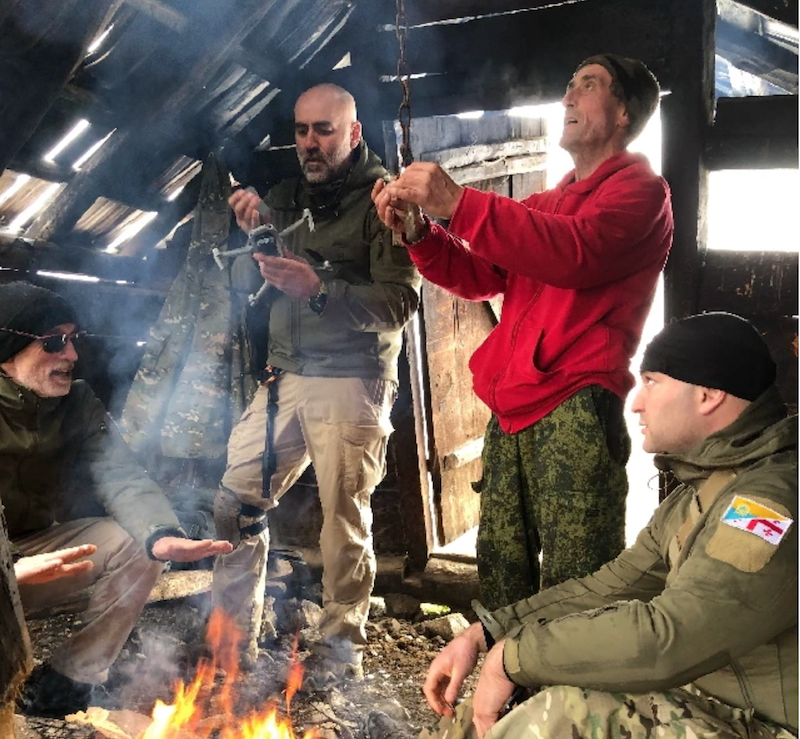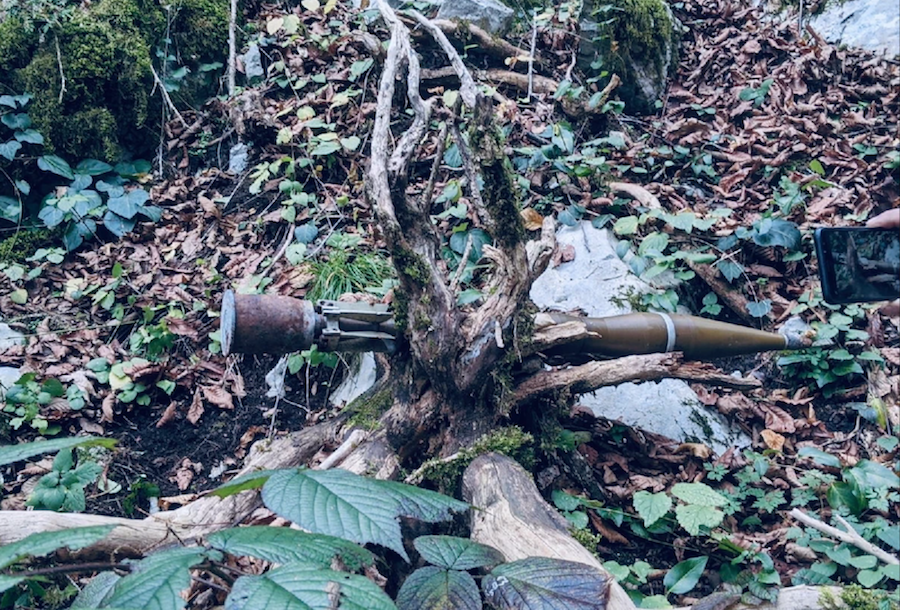Zone of fear: report from the Georgian-Abkhaz dividing line
Georgians in the zone of the Georgian-Abkhaz conflict
A correspondent for the Russian independent newspaper Novaya Gazeta visited the zone of the Georgian-Abkhaz conflict to talk to people who find themselves living in the “gray zone”.
Vist Novaya Gazeta website to read the full article.
“One of them had a pistol. He put the barrel to my leg and told me that I had to go with them”, says Leah (name has been changed), a woman living in the territory, which, according to google maps, is a part of Abkhazia and is controlled by the government, unrecognized by an overwhelming majority of countries.
“I was just looking for a cow”, she continues. “It moved about a hundred meters from our house. They said, “Why did you come here? You have crossed the border of our territory”.
This woman lives in a place de facto not controlled by Tbilisi – in the border zone, where Georgian border guards or police do not dare to enter. Strictly speaking, according to the standards of international law, the Georgian border service is not needed here: after all, de jure its Georgia’s land.
This is what the occupation authorities are using.
- “Our village isn’t occupied, but people are still fleeing” – life in a Georgian village in the conflict zone before the elections
- “We played football with Ossetians in that field” a report from a divided village
“They go back and forth every day”, Leah continues. “Police? No, I don’t think so … The military, rather”.
The road to her house runs between hills and a small forest, winding around an invisible line. Here – we are still in Georgia, and there – already in Abkhazia.
The news that “roaming has turned on” here does not come in the form of text messages, but in the form of a security patrol. Leah says she saw Russian chevrons on the soldiers.
The “creeping occupation” takes place here according to two scenarios. One is the installation of official demarcation pillars – “borderisation”, as the Georgian side calls it. The second is more sophisticated and is, as it were, a prelude to the first one.
“They kidnap people from territories they do not control and say: ‘You see this oak tree – don’t go further than where it stands”, says Dato Katsarava, the leader of a small but rather daring formation, which can hardly be called “non-combat”.
These are, for the most part, veterans, acting without orders from any of the special services, operating in the “gray zone” at their own peril and risk.
People patrolling the border with Dato are not a rule, but an exception to it: there are no regular police officers or border guards with a Georgian flag on their sleeves.

Creeping annexation
In contrast to the ever exploding border of the Ukrainian “gray zone”, the border of Abkhazia is completely calm.
If you want, you can listen to the barking of dogs or eat tangerines.
Leah brings back an armful of fruits plucked from the tree.
A decanter of young homemade wine and the remains of a homemade suckling pig appear on the table: this is Georgia, there will always be something for the table, but there will be no bread in Leah’s house today. The hostess did not have time to buy flour, and it took more than an hour to get to the store along the road winding between “her” and “foreign” land.
The “gray zone” is often surrounded by barbed wire and demarcation pillars, but its conditional border in places is completely transparent and accessible to those who know the paths and loopholes and, with the knowledge and blessings of the special services, is ready to take part in a cross-border operation to supply any cargo: from a kidnapped person to drugs or contraband cigarettes.
Sometimes a ransom is demanded from local residents for “crossing the border”, as it is called here.
The people of Katsarava call “ransom” a bribe to cross the “border”. The authorities of the occupied zones call this a “fine”. Outwardly, this really looks more like a fine than a ransom – the size of the amount does not correspond to the generally accepted ideas about ransom for a kidnapped person.
However, the devil is in the details. In the case of Leah, who lives in de facto Abkhazia, the amount she had to pay for “trespassing” is the equivalent of 200 lari [about $ 60] – a small amount for a tourist, but gigantic for an ordinary Georgian. For many here, this is the size of the monthly pension.
“We call it the “fear zone”, says Dato Katsarava, a former actor turned border guard. A border guard not by profession, but in spirit: every day for three years now, he and a group of former soldiers who became mountain climbers, and climbers who were soldiers at different times of their lives, travels along the country roads adjacent to the occupied territories.
I have been hearing about them since 2018, when I first got to the so-called border at the time of the installation of demarcation pillars with “South Ossetia”.
At that time, these sectors were already patrolled by Dato’s group, which was trying to draw attention to an issue ignored by the official authorities.
“We call it ‘the zone of fear’ because in some places they do not install their poles, but they say:“ Don’t go there, we already control this territory”, says Dato.
Suprisingly, the electricity supplier for the farm where Leah lives is still Georgia.
That is, she pays for electricity in the national currency, lari, but, moving a hundred meters away from the house, she runs the risk of paying a completely different bill in rubles, this time – the bill for “crossing the border”.
Here, as in Ukraine, the “gray zone” territory has no clearly defined political or economic boundaries.
“There are several factors”, says Katsarava. “The first is psychological terror, so that people leave their homes and the places become empty. This is a strategy of intimidation and depopulation. Secondly, they (the FSB border service behind the operations in the “gray zone” – AB) are trying to ‘make it official’. According to them, people violate the “state border”, and that’s why they are fined.
The “abducted” are allowed to sign a document in which the person admits his “guilt”. This is how they legitimize the border”.
Tangerine dreams
Any frontier guesthouse becomes the location of this mobile mobile group. Today their “barracks” are located in the small village of Jvari.
Morning here resembles morning in an impromptu “location of the unit” – tea in a thermos, Abkhaz tangerines on the table.
On the chair next to someone’s jacket, the Georgian and Ukrainian flags are stuck with Velcro in place of the chevron.

Nearby Georgians snore, talking in their sleep. This man’s name is David Ratiani, his family is from Mestia, he himself once lived in Sukhumi.
In the morning I don’t ask what he was dreaming about.
On the same day, the leader of their small group found a shell by the road – an LNG charge removed from an armored vehicle and thrown near a hiking trail nearby.
Dato Katsarava and his guys called the “cops” and gave them the coordinates of the find. Right there, a stream falls from the mountain in cascades, flowing along a small plateau of a narrow picturesque gorge. Here, by the cold stream, the locals have their picnics.
A popular location among the locals is located at the fork in the only road leading from here to Svaneti.
Tariel Kukhilava, a local resident and one of the local tourist guides, gazes at the LNG charge lying in the fallen leaves.
“I’ve been driving people here for ten years. This is the first time I see this!”, he exclaims. “Once upon a time in the 90s the Zviadists hid here…”, he muses aloud.
However, judging by the traces of rust, the shell could have been lying here since 2008, when Russian units entered Georgia in several directions, including the Abkhaz one. It could have been thrown here by the Georgian police themselves, who had not thoroughly dismantled the checkpoint. The place next to which the ammunition was found is located near an abandoned checkpoint.
Sprouted trees from sandbags and behind them a trail with unexploded ordnance lying nearby.
Be that as it may, traces of occupation or “zones of fear” are not only a pistol at the foot, a threat, voiced or embodied in reality.
A “zone of fear” is no-man’s or seemingly no-man’s land where mine clearance has not been properly carried out. The shell thrown here and left unattended is just one of its manifestations.

“Gray zone”: from Transnistria to Tskhinvali
Divided into jurisdictions and regulated by various normative acts, the space of the “gray zone” is a huge area for maneuver for the side that is ready to go into conflict and use force: both military and psychological.
The legal trap in which Ukraine, Georgia, Moldova find themselves, allows the territories that were split off from them to slowly creep into them, taking advantage of fear and impunity.
Another effect of kidnapping on Georgian territory is purely economic.
“From 2008 to 2021, 1,200 people were kidnapped”m says Dato Katsarava.“Fines” start at 2,000 [about $ 27] and can reach 20,000 rubles [about $ 270], depending on the time the person has violated the so-called “border”.
This is a bonus system for soldiers. Their serviceman involved in the abduction receives a two-week leave and some bonuses”.
On the very days when we traveled with Dato and his people in the area of the village of Jvari, he was abducted on another section of the demarcation line (apparently, this time he was indeed abducted – without demanding a ransom disguised as a fine, but he was taken prisoner) a former Georgian soldier who found himself in the “fear zone” on personal matters.
The name of the abducted person is Mamuka Chkhikvadze.
His disappearance was reported by the Georgian security service. This reminded of another episode that ended tragically – the case of the kidnapping in 2018 near Akhalgori (territory controlled by the quasi-government of Tskhinvali) of a man named Archil Tatunashvili, which ended with his death.
All this is also an element of the “zone of fear” and the policy of destabilization.
According to the Georgian Institute for the Development of Freedom of Information (IDFI), every year several kilometers of Georgian land goes into the “gray zone”.
Only in 2013, the occupation “zone” advanced in Bershuti (also a village known for a number of abductions) – by 1.3 kilometers. In the village of Zemo Nikozi (the same one where Mamuka Chkhikvadze disappeared) – 12 kilometers.
In total, after the end of the 2008 war, in the first five years alone, the “gray zone” took control of 103 Georgian villages.
Terms, place names, opinions and publication ideas do not necessarily coincide with those of JAMnews or its individual employees. JAMnews reserves the right to remove comments on posts that are deemed offensive, threatening, violent, or otherwise ethically unacceptable


















